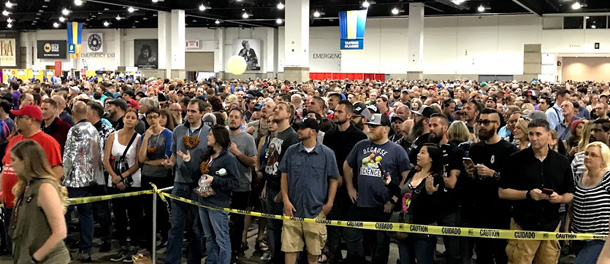If you take the time to work through all the comments that followed Andy Crouch’s suggestion (click on the bird) you might not make it back here, but go look anyway.
I think it's difficult for individuals in other parts of the US (Colorado, California, the Pac NW) to understand how little breweries & consumers in other regions care about the @gabf. In New England, it's rarely discussed, few participate in the event, and consumers don't care.
— Andy Crouch (@BeerScribe) September 24, 2018
As happens on Twitter, different threads developed and more questions came up. Bart Watson will be answering some them soon with what has turned into an annual crunching of numbers. I’ll add the link here. Meanwhile, his reports from 2017, 2016, 2015, and 2014. Lots of fun stuff, including the fact that he calculates expected medals versus actual medals won based on the difficulty of categories entered.

I’ve got three quick items for the three or so of you who are still around after all of that. Or maybe one thought stated three ways.
– I agree that GABF is not the center of the beer universe, and @goodbeerhunting is partially correct that “GABF mostly represents that certain boom era of the early 90s. It contains specific ideals, aesthetics, and preferences that don’t connect with many who pre/post date that ‘movement.'” But I don’t think what happens at GABF says in Denver. Daria and I first attended in 1993. There were 295 “regional specialty breweries, microbreweries and brewpubs” at the beginning of that year and 382 at the end — plus, of course, some larger breweries. Two hundred and six breweries (including Pabst, Falstaff and some even larger breweries) poured beer in Denver. They represented a good portion of the breweries in the country and an even larger chunk of what was brewed.
It would have possible to drink one ounce from each of them, about 6 liters during three sessions. Last weekend 637 breweries had booths, plus there were multiple zones (Pro-Am, Heavy Medal, Collaborations, State Guilds, Jameson Caskmates) with still more beer. Drinking an ounce from each of the 800-plus breweries represented would have been a 24-liter challenge. And given that Anheuser-Busch and Miller Brewing and Coors Brewing no longer exist with those names or pour beer at GABF, plus that there are more than 6,000 breweries, well, a little harder to take the pulse of an industry.
Nonethless, Kate Bernot gives it a shot: “Taken as a whole, the beers poured did offer a glimpse into where American craft beer is in 2018, and possibly where it’s headed in the distant future.”
– The value of GABF competition also popped up on Twitter (and was the subject of an op-ed piece a few months ago). Perhaps this is simply proof I have been doing this stuff too long, but I wrote about this when Miller was still Miller and could win seven medals at World Beer Cup. (Dogfish Head, on the other hand, still hadn’t captured its first GABF medal.) What’s might be most important is that customers care. I defer to something Todd Ashman said for the story, “Your customers can take ownership (of a medal). They think, ‘I had that beer, maybe even some from that batch.’ They associate with the brewery, and they feel good about the place where they are a patron.”
Granted, this was 14 years ago. But even though GABF keeps adding categories, winning a medal keeps getting harder. Watson has proof. That Austin Beer Garden’s Rocket 100 won gold in 2015, 2017, and 2018 is astonishing. Same with Snake River Brewing Speargun Coffee Milk Stout in 2017 and 2018.
– After Carla Jean Lauter wrote “I’d love to see a histogram of how many breweries entered GABF and what size they are” I began looking up production numbers (in The New Brewer May/June issue) of winners. Then I remembered that Watson had broken down winners by size last year, finding “Smaller regional brewers fared the best relative to expectations, but no size grouping jumps off the page as having extremely over or under performed.” Before I abandoned the mind-numbing project I noticed that the silver and bronze winners in the Belgian-style triple category didn’t brew much beer in 2017. It turns out bronze winner Paradigm Shift Brewing in Ohio was open only a month in 2017. Silver winner Village Idiot Brewing in New Jersey has been around a while, but brews beer only 1.5 barrels (46 gallons at a time). That means brewing 117 batches to produce 175 barrels in a year. The — shall we say sad? — discovery checking out Village Idiot was that the beer simply called “Belgian Tripel” on the GABF winners list is known as “Thong Remover Tripel” at the brewery. Nice to see the Brewers Association policy against lewd and sexist beer names in action, but too bad it is necessary. Still work to be done, @beerbabe.